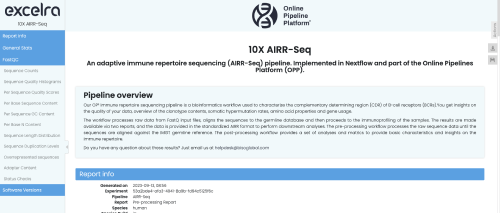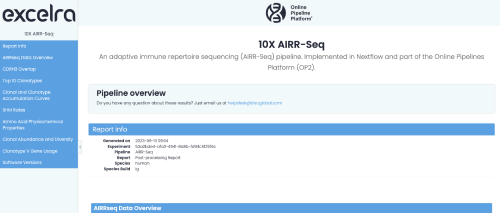10X Immunomics
The 10X BCR immune repertoire sequencing pipeline is a bioinformatics workflow for characterizing the sequences of B-cell receptors (BCRs) with single-cell resolution for libraries generated using 10x technology.
You get insights on the quality of your data, overview of the clonotype contents, somatic hypermutation rates, amino acid properties, gene usage, repertoire overlap and phylogenetic trees.
The workflow consists of two parts: pre- and postprocessing.
The pre-processing workflow processes the raw FASTQ sequence data using the 10x Chromium Cell Barcodes and unique molecular identifiers (UMIs) to assemble V(D)J transcripts per cell.
Results are made available for download in the standardized AIRR-tsv format.
The post-processing workflow provides insights into the immune repertoire, for example, by determination of clonotypes or inference of phylogenetic trees.
Moreover, single-cell resolution enables to take the pairing of heavy and light chains into account, allowing for the complete identification of antibodies.
Interactive HTML reports containing a summary of the results and useful visualizations are made available for both the pre- and postprocessing workflows.
-
1
Input
Demultiplexed FastQ files
-
2
Pre-process Data
Processes Chromium single cell data with Cell Ranger to align reads and generate feature-barcode matrices
-
3
Alignment
Assigns V(D)J gene annotations with IgBLAST
-
1
Input
AIRR tsv with the germline gene annotations
-
2
Clonotyping
Assigns clonotypes and provides a visualization of the clonotype composition and the clone/clonotype accumulation curve
-
3
Amino Acid Physicochemical properties
Provides an overview of potential protein interaction metrics. Here we focus on 9 properties of the HCDR3
-
4
Chain pairing
Pairs heavy and light chains
-
5
Lineage tree creation
Building phylogenetic trees
-
6
Repertoire overlap
Analyse the overlap between repertoires

